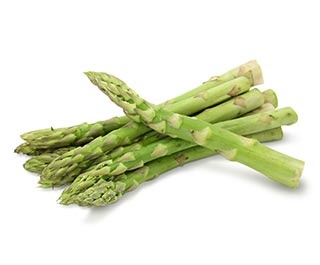Assets of Asparagus
Botanical name: Violetto d’Albenga

Asparagus officinalis belongs to a large genus of plants grown for ornamental purposes, though it's is one of the few members of this family that's cultivated for food.1 Since its domestication, asparagus has become a favorite for its sweet flavor and tender quality, which allows it to be prepared in various ways.2 You can steam, poach, roast or add a handful of its stalks to soups and frittatas for added texture.3
Health Benefits of Asparagus
Aside from its delectable taste, asparagus offers numerous vitamins and minerals, including calcium, folate, iron, magnesium, phosphorus, potassium and vitamins A, K and C. It also contains trace amounts of niacin and vitamin E.4 It’s obvious that asparagus leads the pack in both the range and amount of nutrients it supplies. Because of these nutrients, adding asparagus to your diet may offer the following benefits:
- Supporting cardiovascular health — In a 2017 study from Nutrients, it was stated that numerous vegetables (including asparagus) may protect and support heart health. This may be due to the high amounts of dietary fiber and vitamins in this vegetable.5
- Aiding in fetal development — As one of the best plant-based sources of folate, asparagus may help lower the risk of miscarriage and neural tube defects in unborn children.6
- Lowering osteoporosis risk — Asparagus contains considerable amounts of both vitamin K and calcium, nutrients essential in maintaining bone health. Adequate levels of vitamin K in the body ensures effective absorption of calcium, lowering the risk for bone fractures.7
Asparagus Nutrition Facts
Serving Size: 3.5 ounces (100 grams), boiled, drained8
| Calories |
22 |
|
| Total Fat |
0.22 g |
|
| Saturated Fat |
0.048 g |
|
| Cholesterol |
0 mg |
|
| Sodium |
14 mg |
|
| Total Carbohydrates |
4.11 g |
|
| Dietary Fiber |
2 g |
|
| Sugar |
1.3 g |
|
| Protein |
2.4 g |
|
| Calcium 23 mg |
Iron |
0.91 mg |
Studies Done on Asparagus
The active components of asparagus have been the subject of numerous scientific studies, mainly focusing on steroidal saponin content. In a 1997 study from Planta Medica, researchers isolated two oligofurostanosides from asparagus seeds, which were found to have cytotoxic effects on human leukemia cells.9 This coincides with a 2010 study published in Phytochemistry Reviews, where triterpene and steroid saponins triggered apoptosis in tumor cells and cytoskeleton disintegration.10
Asparagus officinalis extracts may also protect against oxidative stress and liver and kidney damage as reported in a 2018 animal study from Toxicology Reports. Wistar rats were co-administered bisphenol A (BPA) and asparagus officinalis extract (AOE), with BPA inducing oxidative stress in both the liver and kidneys. AOE provided the rats with liver and kidney tissue protection, significantly lowering the effects of BPA.11
Asparagus stem extracts were found to have dermatological benefits as well. A 2018 study from Environmental Health and Preventive Medicine shows that asparagus extracts may help prevent photo aging by inducing the expression of HSP70 during UV-B irradiation.12
In Japan, growth inhibition of asparagus has been considered a major agricultural problem. Due to this, asparagus plants were analyzed to discover the reason. This is still a controversial topic as experts discuss the possibility of chemical or foodborne pathogens, but the study, which was conducted using soil studies in several fields in 2007 and 2008, concluded that the growth inhibition was due to continuous cropping of asparagus.13
Asparagus Healthy Recipes:
Asparagus and Avocado Salad

|
Ingredients:
|
|
✓ 4 to 5 thick asparagus spears
|
✓ 1 avocado, halved, pitted and peeled
|
✓ 16 fresh mint leaves, chopped
|
✓ 1/2 lime
|
|
✓ 2 tablespoons coconut oil
|
✓ Himalayan salt, to taste
|
|
|
Procedure:
- Cut away about 2 inches of the base of each asparagus spear.
- Shave the entire asparagus from bottom to top with a vegetable peeler, reversing your grip and rotating as necessary to shave as much as possible.
- Divide the asparagus strips among four salad plates.
- Cut each avocado half into four sections. Place two wedges on each salad.
- Sprinkle the mint leaves. Squeeze lime juice over the salad, drizzle evenly with the oil and sprinkle with salt.
(Recipe adapted from Epicurious14)
Asparagus Fun Facts
Asparagus is considered one of the oldest cultivated vegetables, with the earliest documentation dating back to 200 B.C., with Cato the Elder discussing its culture and cultivation.15 Pliny the Elder also noted that asparagus needed "the most delicate attention" when it came to its farming.16 It was first introduced in North America in the 1700s by European settlers, and is now cultivated across the country in gardens.17
Summary
The wealth of nutrients offered by asparagus is truly remarkable, especially since it is so nutritionally balanced. Ongoing studies are revealing that this vegetable may have more benefits for the human body than we are currently aware of. Luckily, it's a tasty vegetable with a long list of ways to prepare it, making it an in-season favorite.